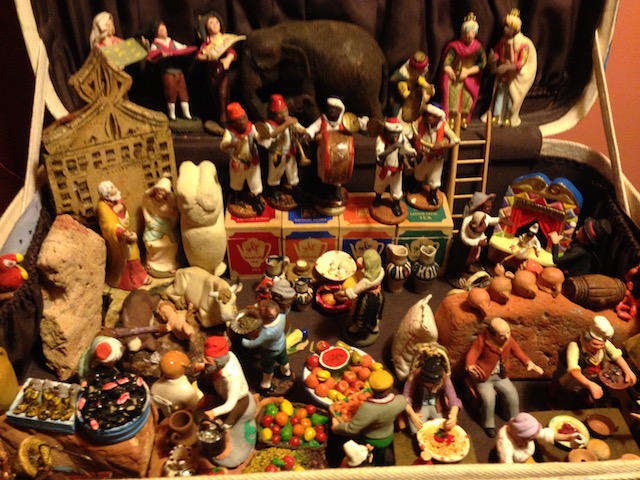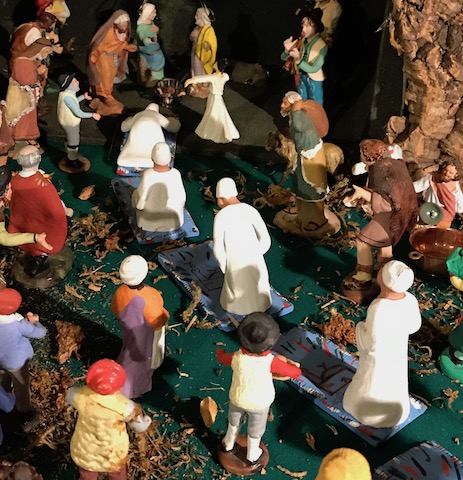Viaggio nel presepio, oltre ogni divieto in tempi di pandemia: come, dove e perché
Viaggio immaginario e millenario, il presepio è da secoli il viaggio collettivo, familiare, personale, di chi altrimenti non può viaggiare.

Viaggio immaginario e millenario, il presepio è da secoli il viaggio collettivo, familiare, personale, di chi altrimenti non può viaggiare.

(English translation below)
Del viaggio nel presepio si raccontano due versioni: partirono il giorno dell’Annunciazione, e arrivarono dopo nove mesi. Oppure furono avvertiti da una cometa, e gli ci vollero soli tredici giorni. In ogni caso arrivarono in tempo, ma per ultimi; i primi furono dei pastori, gente abituata a camminare e alle transumanze, seguiti da bambini e cagnolini, venditori di tappeti, sarti, donne con sporte di pane, e un’umanità plurale e colorata, come quella nella quale ci s’imbatte nelle strade del mondo. Per una notte l’intero mondo si è ritrovato in movimento, al punto che l’albergo è completo, e tutto si fa viaggio, dalla capanna o dalla grotta che dà riparo ai forestieri sfortunati, a queste donne nomadi nelle quali ci s’imbatte di continuo – la zingara col bambino in braccio, che ricorda un altro viaggio, la fuga dall’Egitto; la zingara con i ferri, annunciatrice dei chiodi della Passione; la zingara sola, che aveva annunciato la natività; la zingara con le carte per leggere la ventura. Queste donne affascinanti giunte in Palestina dal Caucaso s’incontrano nei pressi della grotta con altri girovaghi, come la banda dei suonatori dalla pelle nera con i loro strumenti orientali, o il Monaco Cercante, che girovaga distribuendo santini e benedizioni. Sono arrivati anche Gandhi e Teresa di Calcutta.

Il sigillo di questo viaggio corale è dato dal sontuoso arrivo dei Magi, con tanto di elefanti o almeno dromedari. Il vangelo armeno dell’infanzia dischiude il lungo cammino dei tre re: Balthasar dall’Arabia, forse pure dall’Etiopia, Melkon dalla Persia, Gaspar addirittura dall’India. Per Platone, Plutarco, Aristotele o Plinio, i Magi sapevano leggere i sogni e le stelle, e custodivano la dottrina di Zoroastro. Leone Magno I stabilì per decreto il loro numero a tre, mentre prima oscillava tra due e dodici, invece tre erano solo i regali offerti, tutti esotici, trofei di viaggio. In ogni caso, la devozione popolare volle poi vedere in questi gran signori abbigliati sontuosamente, le tre razze bianca, nera e gialla, che viaggiarono per rendere omaggio al neonato re della cristianità. L’anno scorso, in una casa napoletana dove la civiltà del presepio è ancora festa e rigore e, appunto, civiltà di chi lo pratica, ho perfino incontrato cinque maomettani nelle altrettante posizioni rituali della loro preghiera dinanzi al bambino.

Solo nei veri viaggi accadono di questi miracoli ecumenici. Ma l’andirivieni terrestre è poca cosa rispetto ai concomitanti viaggi celesti: alzando gli occhi si vedono schiere di angeli che suonano arpe, flauti, cembali, cantano e volano di qua e di là, e sopra di loro la cometa, che percorrendo la sua orbita parabolica o iperbolica nel firmamento, ha dato da lassù l’indicazione ai viaggiatori di quaggiù. È una teofania di luce riflessa nello splendore dei Magi, che rischiara l’isolamento dei paesini di montagna o le ristrettezze dei bassi napoletani.
Oggi illumina il buio a cui sono costretti gli impediti viaggiatori di questi tempi. Il presepio si potrebbe esporre a ogni sorta di divieto in tempo di pandemia: è una storia di spostamenti e di assembramenti. Invece non è soggetto ad alcuna restrizione, e nel semi-confinamento delle nostre case offre la possibilità di un frutto altrimenti proibito: l’evasione verso l’Oriente, o meglio verso una delle poche forme non kitsch dell’orientalismo. Qualcuno si prende la briga, sublime sospensione temporale, di tirare fuori le statuine e predisporle secondo il suo estro, e in questo modo traslato sarà viaggiatore. Questo regista teatrale sa esplorare questo microcosmo discordante e disordinato, questa verità in un piccolo mondo composto di finzioni, con pezzi di legno che simulano montagne, figurine di gesso terracotta o plastica dagli abiti più improbabili, muschi che fingono di essere pascoli, segatura che evoca deserti, pezzi di specchio camuffati da laghetti e carta da ruscelli. Sono miraggi di una terra lontana eppure vicina (sullo scaffale di casa), di un luogo dall’apparente immobilità nel quale tutto è movimento, e dove, in questo regno dell’individualismo in cui ogni personaggio ha l’aria di pensare solo a se stesso, tutti convergono verso un’unità, grazie al loro mettersi in cammino.
Quando tutta la famiglia si mette a fare il presepio, è una famiglia intera che viaggia; quando, come nel Natale in casa Cupiello, è una sola anima candida e incompresa, essa assapora l’intensità dei viaggi solitari. Altri si astengono dal farlo e si compiaceranno a guardarlo: sono come gli amici a cui al ritorno si fanno vedere le fotografie, o che oggi le guardano pubblicate sui social network. Poi ci sono gli indifferenti, che mai si prodigherebbero ad allestire una capanna e un corteo di statuine, e nemmeno ci soffermano lo sguardo, ritenendo il presepio un giocattolo, per giunta demodé: sono gli stanziali, coloro che mai viaggeranno, e se gli capita restano col paraocchi entro gli orizzonti domestici.
Perché il presepio è da secoli il viaggio collettivo, familiare, personale, di chi altrimenti non può viaggiare. È il teatro geografico del povero, permettendo di avere un pezzo di Palestina dentro la propria casa, di immedesimarsi con magi, pastori, angeli, zingari, stelle in movimento, di accompagnarli, o meglio di lasciarsi accompagnare da loro. E presso la capanna, si lasceranno i resti dei dolci natalizi, come insegna di un’antica e sempre saggia tradizione, per gli altri viaggiatori che non vediamo: le anime vaganti della notte.
E quando potremo tornare davvero a vagare, non dimentichiamo di andare a visitare il Museo del Presepio, fondato a Dalmine da un sacerdote appassionato di quest’arte antica, con oltre cinquecento presepi di epoche e materiali diversi, dal Settecento ai primi del Novecento.
ENGLISH VERSION
There are two accounts of the journey: they left on the day of the Annunciation and arrived nine months later. Or they were warned by a comet, and they made it in just thirteen days. In any case, they arrived in time, but as last ones; the first were shepherds, people accustomed to walking and transhumance, followed by children and dogs, carpet sellers, tailors, women with baskets of bread, and a colorful humanity, like in the streets of the world. For one night, the whole world was on the move, to the extent that the hotel was complete, and everything became a journey, from the hut or the cave that shelters unfortunate strangers, to these nomadic women in which we run into – the gypsy girl with the child in her arms, memory of another journey, the escape from Egypt; the gypsy with irons, herald of the nails of the Passion; the lone gypsy, who had announced the nativity; the gypsy with the cards to read the fortune. These charming women who came to Palestine from the Caucasus meet near the hat with other wanderers, such as the band of black-skinned players with their oriental instruments, or the “Searching Monk”, who wanders around distributing holy cards and blessings. Gandhi, Teresa of Calcutta, also joined the party.
The sumptuous arrival of the Magi, with elephants or dromedaries, sealed this choral journey. The Armenian Gospel of childhood discloses the long journey of the three kings: Balthasar from Arabia, perhaps also from Ethiopia, Melkon from Persia, Gaspar even from India. For Plato, Plutarch, Aristotle or Pliny, the Magi knew how to read dreams and the stars and kept the doctrine of Zoroaster. Pope Leone Magni I established their number at three by decree, while before it oscillated between two and twelve, while three were only their gifts, all exotic, all “travel trophies”. In any case, popular devotion then wanted to see in these great gentlemen dressed sumptuously, the three “races” of human beings – white, black and yellow people, travelling from far away to pay homage to the newborn king of Christianity. Last year, in a Neapolitan house where the civilization of the crib is still celebration and rigor, this being precisely the civilization of those who practice it, I even met five Muslims in the five ritual positions of the pray to Allah in front of the child. Only in real journeys do these ecumenical miracles happen.
The terrestrial movement of people is little thing compared to the concomitant celestial journeys: looking up, you can see throngs of angels playing harps, flutes, cymbals, singing and flying around, and above them the comet, whose traveling parabolic or hyperbolic orbit in the firmament, gave the indication to the travellers down here. It is a theophany of light reflected in the splendor of the Magi and which illuminates the isolation of the mountain villages or the narrowness of the Neapolitan lowlands.
Today the crib illuminates the darkness that the impeded travellers of these times are forced to face. The crib could be exposed to all sorts of prohibitions in times of pandemics, being a story of displacements and gatherings. Instead, it is not subject to any restrictions, and in the semi-confinement of our homes it offers the possibility of an otherwise forbidden fruit: escape to the East, or rather to one of the few non-kitsch forms of orientalism. Someone takes the trouble, sublime suspension of time, to take out the small statues and arrange them according to his or her inspiration – and in this translated way he or she will be travelling to the Holy Land. Acting like a theatre director, he or she knows how to explore this discordant and disordered microcosm, this truth in a small world made up of fictions, with pieces of wood that simulate mountains, plaster terracotta or plastic figurines with the most improbable clothes, mosses that pretend to be pastures, sawdust that evokes deserts, pieces of mirror disguised as ponds and paper from streams. They are mirages of a distant yet close land (on the shelf at home), of a place with apparent immobility in which everything is moving, and where, in this realm of individualism in which each character seems to be thinking only about himself, all converge towards unity, thanks to their setting out. When the whole family starts “making the crib”, it is a whole family that travels; when, as at “Christmas in the Cupiello’s” by De Filippo, there is a single candid and misunderstood soul, he or she savors the intensity of solitary journeys.
Others refrain from doing so and will be pleased to look at it: they are like friends who just look at the photos upon return of our travels. There are also the indifferent ones, who would never go out of their way to set up a hut and a procession of statuettes, and not even stop their gaze, considering the crib a toy, even an old fashioned one: they are the sedentary, those who will never travel, and if it happens to them to travel, they remain with blinders within the domestic horizons. Because the crib has for centuries been the collective, family, personal journey of those who otherwise cannot travel. It is the geographic theatre of the poor, allowing you to have a piece of Palestine inside your home, to identify with Magi, shepherds, angels, gypsy, stars in motion, to accompany them, or rather to be accompanied by all of them. And next to the small hut, the remains of Christmas sweets will be left, as an ancient and always wise tradition teaches, for the other travellers we don’t see: the wandering souls of the night.
